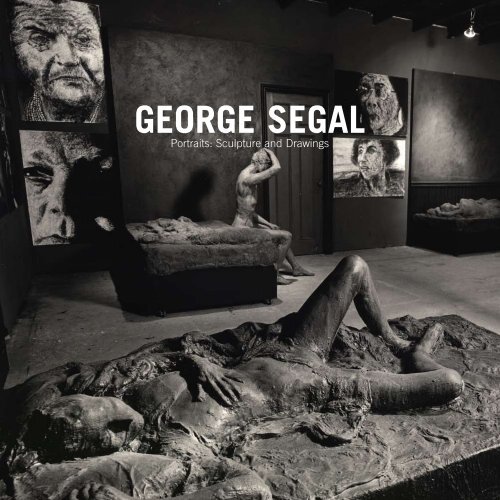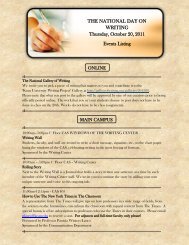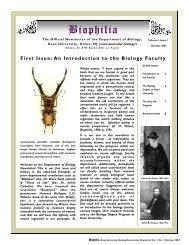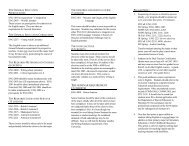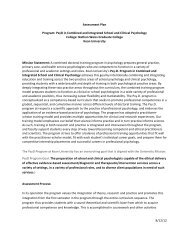GeorGe SeGal - Kean University
GeorGe SeGal - Kean University
GeorGe SeGal - Kean University
Create successful ePaper yourself
Turn your PDF publications into a flip-book with our unique Google optimized e-Paper software.
<strong>GeorGe</strong> <strong>SeGal</strong><br />
Portraits: Sculpture and Drawings
Copyright © 2006 by <strong>Kean</strong> <strong>University</strong>, Union, New Jersey<br />
Essays and photographs copyright © 2006 by individual authors.<br />
All rights reserved. No part of this book may be reproduced in<br />
any form including electronic or mechanical means, photocopying,<br />
and information storage and retrieval systems, except in the case<br />
of brief extracts for the purpose of critical articles and reviews,<br />
without permission in writing from <strong>Kean</strong> <strong>University</strong>.<br />
Published by <strong>Kean</strong> <strong>University</strong> 1000 Morris Avenue,<br />
Union, New Jersey 07083<br />
www.kean.edu<br />
ISBN 0-9765907-2<br />
All works of art by George Segal<br />
© the George and Helen Segal Foundation/<br />
licensed by VAGA, New York, NY<br />
Photos of studio and George Segal<br />
© Donald Lokuta/licensed by VAGA, New York, NY
<strong>GeorGe</strong> <strong>SeGal</strong><br />
Portraits: Sculpture and Drawings
Woman on a Bench, 1997<br />
Photo by Donald Lokuta © Donald Lokuta/Licensed by VAGA, New York, New York
<strong>GeorGe</strong> <strong>SeGal</strong><br />
Portraits: Sculpture and Drawings<br />
KeaN UNIVerSITY GallerIeS<br />
union, new jerSey
View of Room 3, 2000
IntroDuctIon<br />
George Segal’s artwork typically began with the people that surrounded him—friends, professional<br />
associates, even himself—but most often his own family members were the subjects from which he<br />
drew and made life casts. this exhibition at <strong>Kean</strong> university focuses on portraits: an investigation into<br />
the connection between the people that supported his creativity and the artwork that was the outcome<br />
of these relationships.<br />
It is worth noting that George Segal had some personal connections to <strong>Kean</strong> university. In 1984 he<br />
was awarded an honorary doctorate. Around that time he would occasionally make a quiet appearance<br />
on campus to print his photos in the darkroom with his friend, Professor Donald Lokuta. He also gave<br />
several lectures at <strong>Kean</strong> university, and in the early 1970s exhibited his work on campus.<br />
this catalog is published in conjunction with the exhibition George Segal Portraits: Sculpture and<br />
Drawings, held at <strong>Kean</strong> university’s cAS Gallery from April 11 through June 15, 2006. Included are<br />
two essays by the artist, writer, critic and poet, John Perreault. the first was originally published in<br />
Art News in november, 1968. At that time, Segal had already become a major force in modern art<br />
and was having a solo exhibition at the Sidney Janis Gallery in Manhattan. thirty-eight years later,<br />
Perreault returned to the site of George Segal’s studio to observe, and reflect on the artist’s career.<br />
John Perreault’s perspective and insight give us a rich context from which we can appreciate Segal’s work.<br />
this exhibition has been made possible through the generosity of the George and Helen Segal<br />
Foundation, which lent the artwork to <strong>Kean</strong> university. We appreciate the opportunity to bring this show<br />
to the <strong>Kean</strong> university community and are particularly grateful to Helen Segal, rena Segal and Susan<br />
Kutliroff for their support. It has been a pleasure to work together and get to know them. All three<br />
modeled and posed for the artist on numerous occasions, and examples are included in this exhibition.<br />
All the drawings except Self-Portrait have never been shown before and one of the three sculptures,<br />
a portrait of George Segal’s daughter, is being shared with the public for the first time.<br />
We are also grateful for the support and leadership of university President Dr. Dawood Farahi and<br />
Dr. carole Shaffer-Koros, Dean of the School of Visual and Performing Arts, who encourage the growing<br />
exhibition program at <strong>Kean</strong> university. Many thanks, too, to Shawn Mccabe and the Museum training<br />
class for their invaluable participation. they installed this show and were also involved in the exhibition<br />
planning process. Finally, I want to express my deepest appreciation to Professor Donald Lokuta whose<br />
twenty-year association with George Segal and longtime friendship with the Segal family helped initiate<br />
this project in innumerable ways.<br />
Professor neil tetkowski<br />
Gallery Director, Exhibition curator<br />
V
VI<br />
BY nEIL tEtKoWSKI<br />
GEorGE SEGAL PortrAItS:<br />
ScuLPturE AnD DrAWInGS<br />
there is a paradox here. George Segal sculptures are not portraits in the traditional sense, yet<br />
they portray humanity. they take on a universal character in part because of the anonymous<br />
quality of the figures, which appear to be nobody in particular, yet mysteriously they are all people at<br />
the same time. the enduring strength of the work is found in the presence of the human forms,<br />
which typically eclipse the individual and suggest qualities that all people have in common. Images<br />
of people are the central subjects in the work of George Segal. But we rarely think of this artist as<br />
one who made portraits; perhaps universal portraits, portraits of humanity, but individual portraits?<br />
At first glance, the fourteen drawings in this exhibition present a perplexing issue; in contrast to the<br />
sculptures, each drawing is a likeness of the subject, i.e., a traditional portrait.<br />
In the past, it just did not matter to me who had been on the inside of the molded cast, who<br />
the actual people were that had modeled under the skins of plaster that later became great<br />
works of Segal’s art. In fact the sculptures are actually based on negative spaces, like the human<br />
spaces in the lava of Pompeii. A boy is running, but there is no boy. Yet he is still running,<br />
running and running forever. I have been moved by the profound human essence that these<br />
ancient voids of space exude. It doesn’t matter who that specific boy actually was, trapped in<br />
volcanic ash in A.D. 79.<br />
My perspective began to change about a year ago when I had my first opportunity to visit the<br />
Segal Foundation in South Brunswick, new Jersey. I quickly learned a few important things<br />
about how George Segal worked. I learned that Segal did not hire models. Apparently he had<br />
to “feel” something for his model and preferred to work with someone he knew. there had to<br />
be a connection, a “chemistry.” So, like a shaman, the magic of this artist was to transform the<br />
singular into the collective, to assist the individual in a white costume to take on the collective<br />
spirit. through Segal’s plaster ritual, the artist’s subject took on the universal power to represent<br />
all people, potentially a race of equals.<br />
upon entering the tranquil studio of George Segal one is surrounded by artwork. room after<br />
room contains life-size installations. Some works are specific sculptures that are very recognizable,<br />
well-known artworks, such as the Depression Bread Line at the FDr Memorial in Washington, D.c.<br />
I knew that my friend and colleague Donald Lokuta had been one of the models for that famous<br />
group of five men that commemorate the Great Depression and symbolize the universal sorrow of<br />
hard luck and misfortune. What was news to me was to learn that the artist himself modeled for
Drawing in Progress, “Sophie V”, 1996<br />
that sculpture, and the other three figures were dear friends of his. that is how the first visit went.<br />
one after another, as I encountered the sculptures, I learned that each piece had a very specific<br />
story of who modeled. those who had been closest to the artist were eager to share fond<br />
memories and inside jokes. the static plaster objects were a link to their common past, like<br />
memory boards or modern-day snapshots.<br />
these intimate moments were never intended to be carried into the public arena. And just as<br />
a well-known actor finds it counterproductive to bring personal real-life problems onto the stage,<br />
I believe this artist intended to leave many details out of the artwork in order to make a stronger,<br />
clearer and more powerful impact with his work. In everyday life, distractions are everywhere: in<br />
art it is not so. George Segal was a master editor of life presenting his feeling for life with basic<br />
forms, basic relationships and basic issues. Because of this underlying truth I have come to see<br />
the figures of George Segal as actors carefully choreographed within a minimalist environment.<br />
So there you have it, a clean and easy rationale to explain away the portrait question. However<br />
a rather important problem still looms. George Segal was not a simple person or one who made<br />
simple art. When considering his artwork in general and his drawings specifically, you need to bear<br />
this in mind. Before Segal was an artist, he was a chicken farmer, and before he was a sculptor he<br />
VII
VIII<br />
was making drawings and paintings. this is not a chicken and egg question. It is a fact. Drawing<br />
came first. And going way back, he dealt with many subjects; like a loving dad, he drew his sixyear-old<br />
daughter, and like a Pop artist of the 1960s, he drew ketchup bottles. George Segal was<br />
an artist of many moods, many interests and many ideas, and he always drew.<br />
the drawings in this exhibition are all of specific people, most untitled by the artist, with the<br />
name of the person rendered in parentheses. All of his subjects were friends, neighbors and family.<br />
However, some of the artist’s own family members insist that it does not matter who the subjects<br />
were in the drawings: “they were just people.” All well and good, but some are famous people<br />
such as Lucas Samaras and Marisol, whom he knew well. He would go to the movies with Abba<br />
Eban, the former Minister of Foreign Affairs of Israel. they were friends.<br />
I believe George Segal’s relationships with the people in his personal life were something he<br />
considered sacred. By incorporating friends and family into his art, the artist/shaman immortalized<br />
his subjects. I doubt it was a conscious effort. But this way of working shows up like a repeated<br />
pattern. In the studio there were many drawings of hands, Clasped Hands, the same pair of<br />
hands. Drawn over and over, they are his wife Helen’s hands. In this way, the drawings and the<br />
objects he made often embodied those he admired. Most of all, his art captured the spirit of those<br />
he cared for and loved most. George was always drawing. As his health began to decline and<br />
the physical activities associated with making sculpture were getting increasingly strenuous and<br />
fatiguing, photography and drawing became natural outlets for his creativity. Most of the drawings<br />
in this exhibition come from that time, 1998-1999.<br />
When I was selecting the works for this show a large beautiful drawing of Willie nelson caught<br />
my eye. I chose not to include that drawing since I imagined that the star quality of the personality<br />
could be a distraction from the exhibition. I include the story now because it tells of the funny and<br />
light-hearted side of the artist. George Segal did not know Willie nelson. He just liked his music<br />
and I bet he admired him as well. two of the major sculptures in this show are not titled after<br />
the models. one is simply called Woman on a Bench, the other, Seated Woman. that is how it<br />
usually was. throughout his career, most of Segal’s major sculptures had generic titles without<br />
the model’s name, but the drawings more often than not were more specific. Sometimes a generic<br />
title like “Bob” referred to a specific person whose first name was indeed Bob.<br />
Segal always did his art his own way. What worked for a specific situation was what he went<br />
with. Is that a contradiction? Perhaps it is for some people, but not to George Segal. Does it matter<br />
that the woman on the bench is Susan Kutliroff, his niece, or that the seated woman is the artist’s<br />
wife? For most of the world it is not going to matter. It is information that will just get in the way.<br />
But for those in George’s inner circle, they certainly delight in the likenesses they see in the various<br />
sculptures of the “anonymous people.” It is often their secret just who the specific individuals are.
BY JoHn PErrEAuLt<br />
GEorGE SEGAL’S MoDELS<br />
I. This Is Not a Portrait If I Say It Isn’t<br />
It has been my privilege to have published writings about George Segal’s work twice in the<br />
past, once for Art News (“Plaster caste,” november 1968) and then for The Village Voice<br />
(“Plastered People,” october 24, 1974). the first is reprinted as part of this catalog; the second<br />
was primarily a profile. upon the occasion of an exhibition of three sculptures and a selection of<br />
late works on paper, this third installment of my protracted attempt to come to grips with Segal’s<br />
oeuvre, now several years after the artist’s death, can be, I hope, both a summation and an<br />
attempt to cover some new ground.<br />
Is Segal’s work that difficult? thirty-eight years is a long time to spend circling any art, but<br />
I maintain that Segal’s oeuvre is more complex than it at first appears. Because he usually<br />
presents plaster casts of what appear to be ordinary people in fragments of commonplace<br />
environments, ranging from kitchens to parking garages, his sculptures are approachable in a<br />
way that more abstract three-dimensional art might not be. Yet issues of presentation, media,<br />
and portraiture still fascinate and offer tantalizing conundrums.<br />
Segal’s sculpture is unusual. It would be correct to label much of his work tableaux. Yet even<br />
though his life casts are mostly displayed within frontally deployed “stage-sets,” his tableaux are<br />
otherwise unlike any other examples of this peculiar genre. tableaux might best be represented<br />
by the Victorian tableau vivant once the rage in church cellars and Grange Halls all across<br />
America, in which costumed amateurs stood frozen in narrative poses in front of apparently<br />
enraptured audiences. nothing could be farther from allegorical subject-matter than Segal’s<br />
workers, lovers, artists and housewives. Even when he dares to tackle the Biblical, as in<br />
The Legend of Lot, 1962, or his bronze Abraham’s Sacrifice of Isaac, 1979, the drama is<br />
increased because the characters disconcertingly look like people who might live next door.<br />
Segal steers clear of nymphs, Greco-roman gods and goddesses, and personifications of Liberty<br />
or Justice. on the other hand, his figures seem to personify something. Loneliness? resignation?<br />
Mystical withdrawal?<br />
Furthermore, although we have settled down into calling Segal’s work sculpture without<br />
any qualifications, it might be helpful to remember that there was once a genre called<br />
“environments” and that now we are overwhelmed by “installations,” both of which attempt to<br />
1
2<br />
George Segal With Model, 1998<br />
encompass larger spaces than traditional sculpture and preclude the lonely statue on its lonely<br />
pedestal. then too, critic Irving Sandler once referred to Segal’s plaster tableaux as “frozen<br />
Happenings.” Given the social context of Segal’s move from painting to tableaux, this is apposite,<br />
but one also needs to know that during the early 1960s Segal was particularly close to Allan<br />
Kaprow, deemed the inventor of Happenings. Kaprow was teaching at Douglass college, in new<br />
Brunswick, new Jersey, which was closer to the still-operative Segal chicken farm than 10th<br />
Street—then the center of second-generation Abstract Expressionism—across the Jersey<br />
Meadows and the Hudson river.<br />
Happenings were a kind of artists’ theater with roots in Dada and Futurist performance. I used<br />
Segal’s description in my Village Voice profile:<br />
Yvonne Rainer danced on the roof. That was part of it. There were seven<br />
Happenings I think. Yes, things were really going hot. Allan Kaprow called<br />
me up and asked me to loan my grounds. They expected 50 or 60 people.<br />
The thing mushroomed to over 400. Kaprow did a whole thing that was like
Macbeth. LaMonte Young was tootling a saxophone on top of a haystack and<br />
an army armed with twigs from the woods, advanced against cars. Originally,<br />
Kaprow wanted to be riding a 20-ton bulldozer, I refused to get it for him…In<br />
those years it was wide open to all possibilities. We were convinced we were<br />
forging a new language as good as if not better than Cubism. 1<br />
Happenings, in their preference for the mundane as opposed to the Abstract Expressionist<br />
sublime, lead directly to Pop Art. roy Lichtenstein, also known to Segal, was one more artist<br />
teaching at Douglass; claes oldenburg was presenting his Happenings in Manhattan. And<br />
since Segal was incorporating fragments of the Pop environment, he was often grouped with<br />
Lichtenstein, oldenburg, Jim Dine, and even Andy Warhol. It didn’t seem to matter that<br />
his version of the mundane was the mundane/sublime. From the start, Segal’s art showed<br />
sympathy, elicited empathy, and conveyed complex emotions. there is, of course, a delicious<br />
ambiguity. Are his personages frozen in anxiety or frozen in thought?<br />
Segal is generally acknowledged as a leading artist, far beyond the Pop Art packaging that<br />
catapulted him to early fame. nevertheless there are themes that need to be unraveled, depths<br />
that need to be grasped. It is not that his work bears no relationship to Pop—his chunks of diners<br />
and gas stations still startle—but that the emotions are so different—thoughtful, mournful, critical.<br />
there are formal issues too, beyond his use of abstract painting’s negative space in sculpture<br />
and his depedestalization of three-dimensional forms. color in his work has not yet been fully<br />
examined, nor has his use of photography late in his career. And there are issues of taxonomy.<br />
In terms of the later, I will concentrate here on what I call the portrait paradox.<br />
to begin with, the two wall pieces, the free-standing sculpture and the works on paper in the<br />
exhibition at <strong>Kean</strong> university suggest the need for a reexamination of the role of the model in<br />
Segal’s work; the specificity of Segal’s subjects is often dismissed, since it is commonly thought—<br />
and in fact was stated by the artist himself—that the plaster and, later, bronze figures were types<br />
rather than portraits, just as their equally important settings were typical diners, garages, and so<br />
forth, and not intended as specific ones. But although Segal’s personages are mostly workers<br />
and people one might pass in the streets, portraiture is just beneath the surface, as it were.<br />
until he began employing a two-part investing process in the 1970s, he used the shells composed<br />
of plaster-soaked bandages in themselves, so that the model’s negative form, warts and all, was<br />
unseen inside the sculpture.<br />
He reported that since he had not yet discovered that a lubricant was necessary, his first<br />
foray into body-casting (Man Sitting at a Table, 1961) still contains some of his body hairs in<br />
its interior, since they were stripped away quite painfully when the hardened cast was pulled off.<br />
1. John Perreault, “George Segal: Plastered People,” The Village Voice, october 24, 1974<br />
3
4<br />
More famously, his commissioned double portrait of Pop Art collectors robert and Ethel Scull<br />
(1965), much to her dismay, captured and still holds one of Ethel’s expensive courreges boots.<br />
Segal returned to the self-portrait both overtly and covertly several times. In 1968, the work<br />
shown on the cover of Art News was titled Self-Portrait; showing the plaster simulacrum of the<br />
artist holding a plaster head, standing behind a seated, headless, plaster woman. Another<br />
example of the self-portrait, but not labeled as such inside the magazine, is Artist in Studio,<br />
showing the artist at work drawing two plaster figures deployed on a plaster mattress, two walls<br />
covered with pastels of nudes.<br />
II: When Does a Depiction Become a Portrait?<br />
the American modernist painter charles Demuth sometimes painted objects, letters, and<br />
numbers as stand-ins for faces. For instance, the number five in his “portrait” of William carlos<br />
Williams refers to Williams’ poem that begins “I saw the number five.” A particular person can<br />
be represented by particular things. robert rauschenberg, the Proto-Pop pioneer, famously sent<br />
a telegram to a French art dealer who had requested a portrait, saying “this is a portrait of Iris<br />
clert if I say it is.”<br />
At the opposite end of the portrait spectrum we have nearly photo-realistic depictions done<br />
by thomas Eakins in the 19th century, where, if we could travel back in time, we imagine we<br />
could exactly match the person to the painting, one subject and no other. the best portraits,<br />
of course, are about more than physical likeness; we like to see character and psychology.<br />
Was the subject generous, brave, and kind? Was he or she proud or humble, diffident or difficult?<br />
It should be noted, however, that rarely does the portrait, traditionally paid for by the subject,<br />
show unflattering traits. All blemishes of both face and character must go. Portrait-painters of a<br />
more unfettered eye and hand, such as the late Alice neel, gained few commissions and focused<br />
on family members and Bohemian friends who were less likely to rebel against her painterly<br />
“soul-catching.” And although neel sometimes thought of her victims as types, deemed a banker<br />
or a student or a pregnant woman, they were also specific people. the young man she always<br />
referred to as the wolf-boy, for instance, was the soon-to-be-prominent artist robert Smithson.<br />
How then are we to categorize Segal’s plaster sculptures? Assuming that the artist in all cases<br />
has provided his own titles, we might use these as clues. If the word “portrait” and/or the full<br />
name of the model is used in the title, then there can be no doubt that a portrait of a specific<br />
person was intended. Examples would be Segal’s first commission Man Leaning on a Car Door<br />
(robert Scull), 1963; Richard Bellamy Seated, 1964; John Chamberlain Working, 1965-67; Vera<br />
List, 1965; Man in A Chair (Helment von Erffa), 1969; and Portrait: Plaster Figure of Sidney Janis
with Mondrian’s Composition, 1933, on an Easel, 1965. these are a collector, an art dealer, an<br />
artist, and an arts patron.<br />
In truth, Segal steered away from formal commissioned portraits, and they form but a small<br />
part of his body of work:<br />
…It would be relatively simple using this method [plaster casting] to make<br />
uncannily accurate portrait sculpture. Mostly portrait sculpture is aimed at<br />
putting the sitter’s best foot forward and most sitters who are paying hard cash<br />
for a portrait are not interested in psychological probing. I suppose that’s the<br />
reason I avoid straight sculptures as much as I can, unless the person posing<br />
for me is willing to accept my particular kind of treatment (which is generally<br />
kind, but not glorifying). 2<br />
A second category of depiction—and in terms of portraiture perhaps much more controversial,<br />
given the artist’s stated intentions—would be that of persons not referred to in titles but known to<br />
the viewer through secondary sources. If we happen to look through the 1979 Walker Art center<br />
(Minneapolis) catalog for George Segal: Sculptures, one would learn that the then Director of the<br />
Walker, Martin Friedman, posed as the customer in Segal’s Hot Dog Stand. Friedman’s account<br />
of that experience (“A coat of nivea cream, a lubricant, was smeared over my hands and the<br />
chest area exposed by the open shirt….”) is part of the exhibition catalog. that decidedly<br />
changes how we see the sculpture: the humble “customer” is a museum director!<br />
More dramatically, since it is Segal’s first full-scale tableaux, is The Dinner Table 1962.<br />
the models include the now well-known artist Lucas Samaras, Kaprow and the dance critic<br />
Jill Johnston. Segal is quoted as saying: “I usually make sculpture of people I know very well in<br />
situations that I’ve known them in…as long as there has been a very alive emotional experience<br />
between me and the person.” Given the history of the artist’s friendships, this would certainly<br />
apply to The Dinner Table, for these are precisely the people that might be visiting Segal at his<br />
new Jersey chicken farm during that period. the viewer might not know or care who robert<br />
and Ethel Scull were, but it might be of interest to note that Samaras and Kaprow were friends<br />
and models. then, if you happened to have met one of the artists, as I have, another level opens<br />
up. Jill Johnston, of course, I knew well, since she was the dance critic at The Village Voice<br />
where I also worked.<br />
And then there is the third level of portraiture, which is recognized only by a very few, in<br />
Segal’s case a kind of unintended portraiture attained by and seen by family, friends not in the<br />
public eye, and perhaps the intimates of a very occasional professional model. Works with first<br />
names in their titles would be closer to portraiture than those without, since specific persons<br />
2 Phyllis tuchman, George Segal, Abbeville Press, 1983<br />
5
6<br />
Entrance to the Segal Studio, 1999<br />
are indicated rather than types: e.g., Sophie, Bob, Pam, Suzane. And then at the fourth level,<br />
containing most of Segal’s work, titles are generic in terms of both personages and place, such<br />
as Man on a Bus, The Bar, Woman Looking Through Window, etc. Here I offer another quote<br />
from Segal himself, one that I find particularly helpful in describing his work:<br />
I discovered that ordinary human beings with no great pretensions of being<br />
handsome were somehow singing and beautiful in their rhythms. the people<br />
that I prefer to use again and again as models are friends [and relatives] with a<br />
very lively mental life…I discovered that I had to totally respect the entity of a<br />
specific human being, and it’s a whole other set of insights, a whole other set<br />
of attitudes. It’s a different idea of beauty and it has to do with the gift of life,<br />
‘the gift of consciousness, the gift of a mental life.’ 3<br />
3 Barbarelee Diamonstein, “Segal,” Inside New York’s Art World, Rizzoli, 1970
III: Now on View<br />
What then are we to make of the works in this present exhibition, particularly in terms<br />
of portraiture?<br />
Rena Against the Door, 1988, is a wall piece or relief that shows a pensive young woman with<br />
her hand to her chest, with fingers spread out. Wearing a jacket or coat thrown over her shoulders,<br />
she is posed against a very worn door. Her head is directed to her right, tilted slightly down.<br />
one cannot say “looking down” because as usual Segal makes little of the eyes or where the<br />
eyes should be. the smile is beatific, unusual for a Segal. the model’s name is included in the<br />
title, so according to my scheme, this is a quasi-portrait. rena is, in fact, the artist’s daughter.<br />
But she could also be everyman’s daughter or perhaps the “daughterness” in any young woman.<br />
Bas Relief: Seated Woman, 1966, is also a wall piece. Half of a woman, seated on half of a<br />
chair on a black floor (shelf) in front of a black rectangle that is also a brick wall, painted black.<br />
the forehead just clears the top of the rectangle. At the extreme left of the floor/shelf is the<br />
narrow side of an antique, silver-painted radiator. We happen to know that the model was Helen,<br />
the artist’s wife, but does the viewer need to know? Although seen from the side like Whistler’s<br />
mother, the radiator is prominent and the facial expression is resolute. this is a winter sculpture.<br />
the third sculpture, Woman on a Bench, 1997, is freestanding and, unlike the other two,<br />
technically not a relief. Yet, although it is firmly planted on the ground and the woman is fully<br />
three-dimensional, as is the bench, the frontal deployment and the fact that you cannot walk<br />
around it makes it seem like a relief. Because of Segal’s casting procedure, all of his figures<br />
are more or less life size. nevertheless, the woman—we don’t really need to know that the<br />
model was Segal’s niece and definitely not a bag lady—appears considerably larger than life.<br />
Because the woman, the bench and the brick wall behind are all painted black there is a<br />
feeling of night, which may be a metaphor for her mood (or Segal’s). But she sits there with<br />
considerable dignity and radiates a protective bubble around her possessions and the bench,<br />
too. She is her possessions; she is this bench and no one is going to budge her.<br />
When I re-visited the Segal studio—my third time in thirty-eight years—it seemed more like a<br />
private museum than I remembered. In the nearly block-long space without the artist’s presence,<br />
without the artist’s voice, the sculptures seemed particularly uncanny. then, too, there was the<br />
experience of seeing some of Segal’s models in proximity to their plaster selves: niece Susan<br />
Kutliroff next to Woman on a Bench; Helen Segal next to Seated Woman; photographer and<br />
teacher Donald Lokuta next to one of the figures in Depression Bread Line.<br />
7
8<br />
on some level, Segal must have had an inkling that his types could also be seen as portraits,<br />
for in an interview he once said: “I don’t do the details by which we ordinarily recognize people.<br />
they’re portraits in the same way you recognize a friend walking down a street from a block<br />
away.” 4<br />
When we come to the fourteen out-sized charcoals and pastels that are numerically the largest<br />
part of the <strong>Kean</strong> university exhibition, we need to deal with a mirror-image of the type/portrait<br />
situation presented by the three sculptures. All of the works on paper are unmistakably portraits<br />
of one kind or another, ranging from the splendid self-portrait, through portraits of the well-known<br />
Pop artist Marisol and the Israeli politician Abba Eban (a personal friend of Segal’s), to the<br />
ten “untitled” portraits of various friends and family members, all designated parenthetically by<br />
first names only. Just as the willful reversal of the artist’s emphasis on creating types rather than<br />
portraits in most of his sculptures allows one an autobiographical perspective, seeing the late<br />
works-on-paper as types rather than portraits affords an escape from either/or formulae: specific<br />
faces become an old man, an old woman, a sports fan. Marisol and Abba Eban become people<br />
you might see on a bus.<br />
one, therefore, might end by saying that, just as Segal’s art is for the most part both painting<br />
and sculpture, his subjects—whether embedded in tableaux or on paper, whether cast from<br />
named and/or known models or not—are types and portraits; and portraits of “actors” (e.g.,<br />
Kutliroff as a bag lady) pretending to be types.<br />
John Perreault is a past President of The American Section, International Association of Art Critics; a poet,<br />
artist, and the founder of Artopia (www.artsjournal.com/artopia).<br />
4. Quoted in Tuchman, George Segal.
By John Perreault<br />
Plaster Caste<br />
now that Pop Art per se is no longer an issue, now<br />
that this constellation of styles has been assimilated<br />
and its shock value neutralized — campbell’s soupcan<br />
waste-paper baskets are a glut on the market<br />
and camp, by its very nature a super cliché, has<br />
become an ordinary cliché — it is significant, nevertheless,<br />
that several of the artists labeled, extolled<br />
and sometimes, unfortunately, dismissed as Pop have<br />
continued to develop and to produce new works of<br />
high quality.<br />
one such artist is George Segal; his December<br />
show (1968 at Janis Gallery, new York city) will do<br />
much to establish his position as, surprisingly,<br />
though a major artist who, along with three or four<br />
of the other Pop Popes, proves his art is artful<br />
enough to survive the labels that served as handy<br />
introductions but not as adequate definitions. the<br />
shock of seeing Segal’s plaster molds of real people<br />
located within the pristine arrangements of found<br />
objects has been mitigated by familiarity; we are now<br />
able to perceive just how judicious and significant<br />
are the multiple choices that go into the creation of<br />
one of Segal’s poignant and yet strictly unsentimental<br />
“slice-of-life” evocations.<br />
Segal has the distinctions of being a new York artist<br />
who lives in new Jersey. He lives outside of north<br />
Brunswick with his wife and two children on what<br />
was formerly a chicken farm. Indeed, he was once a<br />
chicken farmer himself and his neighbors, either<br />
unimpressed or uniformed about his more recent<br />
achievements, still think of him as this, even though<br />
his abandoned “coop,” which is several city blocks<br />
9<br />
Art News 1968
Art News 1968<br />
10<br />
long, houses a workshop and numerous, incongruous plaster inhabitants.<br />
Segal began as a painter. In the late ’50s, his friendship with Allan Kaprow, who was then teaching<br />
nearby at rutgers university (robert Whitman and Lucas Samaras were students and roy<br />
Lichtenstein was teaching at Douglass college), played an important role in his development. Segal<br />
later became acquainted with claes oldenburg, red Grooms and other artists centered around the<br />
Hansa Gallery, and had his first show at the Green Gallery, like Hansa under the direction of Dick<br />
Bellamy. From the beginning plaster people were his trademark.<br />
In his recent works, after a venturesome but unprofitable side-trip into painted figures and allegory,<br />
Segal achieves a balance that is post-Pop, post-painterly and pre-apocalyptic. In short, by combining<br />
aspects of several different categories—painting vs. sculpture, presentation vs. representation, art vs.<br />
life—he has managed a significant statement about both art and life.<br />
one can find much to praise in his careful contrasts between real (presented) objects and made<br />
(represented) figures: plaster bodies in contrast to wood, rattan, glass and even daylight. His mediamix<br />
is canny. Subway uses moving lights to suggest the motion of a subway car between stops.<br />
the blinking PArK sign in Parking Garage, a major piece in the Janis show, is perfect. His sense<br />
of composition, although arrived at through an anti-compositional stance, is classic without being<br />
rigid or cold.<br />
In his new works, Segal re-introduces the self-portrait. Self-Portrait with Head and Body depicts<br />
Segal himself in the act of placing a plaster head upon a plaster body. the figure is the same one<br />
employed in a finished state in Girl Sitting against Wall, notable for its almost supremist severity of<br />
composition. Artist in Studio shows Segal or the plaster ghost of Segal in the act of drawing two<br />
models (also plaster). the tableau is backed up by a wall on which a series of large drawings are<br />
displayed. With these two pieces Segal manages to create works of art that are about themselves<br />
in a new and very complicated way.<br />
Artist in Studio is illuminating because it reveals the central formal issue of Segal’s work—until<br />
now disguised by the shock of his commonplace subject matter. For Segal, the concept of “boundary”<br />
is crucial. He not only makes choices involving model (mold), pose and suggestive environmental<br />
fragments, but also major decisions about boundaries. Where will a piece end? How much is just
enough? Should the linoleum beneath the plaster<br />
figures be discarded? the open bag of plaster?<br />
the rafters of his studio?<br />
on the other hand, the most obvious<br />
characteristic of Segal’s work is his consistent<br />
use of isolated figures within contexts that are<br />
widened by his skill in selecting evocative props<br />
(the perfect motel bed in The Motel Room,<br />
the shower stall of Shower Stall, the metal<br />
corner-guard affixed to The Parking Garage).<br />
this characteristic suggests the paintings of<br />
Edward Hopper. the mood is somewhat the<br />
same, as is the mode. And, like Hopper, Segal<br />
is not an American Social-realist, but a poeticrealist.<br />
this phrase seems to be an unnatural<br />
conjunction of polarities. reality, however—if we<br />
mean by “reality” total rather than exclusively<br />
cerebral or visual experience—is unavoidably<br />
poetic and not, contrary to certain therapeutic<br />
but false philosophies, composed of mere facts.<br />
Facts when inspected with even a minimum<br />
degree of attention dissolve into ephemeral<br />
sense data or, on the other hand, into vague<br />
subjective states. Segal is able to transform<br />
facts—shoes, drinking glasses, subway cars—<br />
into emotions.<br />
In regards to the plaster figures themselves,<br />
11<br />
Art News 1968
Art News 1968<br />
12<br />
these hollow men and women are a cast of characters that achieves a kind of blue-collar universality. they indicate<br />
the American yoga of physical and psychological exhaustion.<br />
the bodies, or the imprints of these bodies, exist in three-dimensional space, but their thoughts or their souls<br />
are elsewhere, outside the workday world. Segal is a poet. But he is never oppressive, didactic or “literary.”<br />
He celebrates acceptance. Acceptance, however, must not be read as resignation. Wisdom is contained in the<br />
location of the differences between these apparent similarities.<br />
Segal exploits the language of the body. He does not use the heroic poses of traditional representational sculpture,<br />
but the everyday postures that communicate unconsciously (Indeed, in some systems or anti-systems of thought,<br />
the physical manifestation of a psychological state is the psychological state.) Facial expressions, because they are<br />
created by muscles too subtle to be captured by Segal’s techniques of “mummification” (cloth soaked in wet plaster<br />
is applied directly to the live model), are automatically eliminated, and the body itself, as in dance, bears the burden<br />
of expression. the body, however, even when immobile, is capable of sending a message of great complexity. the<br />
way a man sits, lunges, slumps or arranges himself in a chair contains more history and more truth than all the<br />
personality profiles in the world. the body does not lie. the language of the body—-the relationship between limbs<br />
and torso, muscle tensions, posture and carriage—-offers a rich vocabulary of signs.<br />
the “working-class,” un-Mod tonality of Segal’s iconography is satisfying, not because it approaches certain<br />
Marxist or Ash-can clichés, but because his blue-collar prototypes—-a parking-lot attendant, a girl putting on a<br />
pair of shoes—represent aliterate personalities (as opposed to fashionably normative “post-literate” ones) who<br />
have not ritualized their body language into “manners” that determine “correct” ways of sitting, standing, moving.<br />
Segal brilliantly exposes this forbidden vocabulary of gestures. the bodies of Segal’s faceless (wordless) people<br />
become all face.<br />
What Segal captures with almost infallible grace is the moment of stasis, the significant pose. His figures are<br />
poised between the physical and the spiritual and can be read either way, just as certain Gestalt illustrations can<br />
be read as ladies or rabbits, lovers or pottery. He rarely descends into bathos or social commentary. At his best<br />
and most “poetic” he succeeds in expressing the universal in terms of the particular. What more can we ask?<br />
First printed in Art news, November 1968. Copyright, John Perreault.
Portraits: Sculpture and Drawings
14<br />
Untitled Portrait (Miles), 1998, pastel on paper, 50 x 38 inches
Untitled Portrait (Miles II), 1998, pastel on paper, 38 x 50 inches<br />
15
16<br />
Untitled Portrait (Suzane), 1999, pastel on paper, 30 x 44 inches
Untitled Portrait (Neysa), 1998, charcoal and pastel on paper, 30 x 44 inches<br />
17
18<br />
Pam (with white & gray sweater), 1999, charcoal on paper, 30 x 44 inches
Untitled Portrait (Bob), 1999, pastel on paper, 30 x 44 inches<br />
19
20<br />
Untitled Portrait (Jeff), 1999, charcoal and pastel on paper, 50 x 38 inches
Bas Relief: Seated Woman, 1996, plaster, wood and metal, 53 x 42.375 x 16.25 inches<br />
21
22<br />
Self-Portrait, 1995, charcoal on paper, 30 x 44 inches
Untitled Portrait (Helen X), 1999, pastel on paper, 30 x 44 inches<br />
23
24<br />
Sophie (with black glasses), 1999, charcoal and pastel on paper, 30 x 44 inches
Untitled Portrait (Abba Eban), 1999, pastel on paper, 38 x 50 inches<br />
25
26<br />
Untitled Portrait (Rena in Striped Sweater), 1999, pastel on paper, 44 x 30 inches
Rena Against Door, 1988, Private Collection: rena Segal, wood and plaster, 30 x 28 x 12 inches<br />
27
28<br />
Untitled Portrait (Menasha), 1998, charcoal and pastel on paper, 50 x 38 inches
Marisol (in brown coat), 1999, charcoal and pastel on paper, 30 x 44 inches<br />
29
30<br />
George Segal, 1924 -2000<br />
George Segal was born in new York on november 26, 1924 to a Jewish couple who emigrated<br />
from Eastern Europe. His parents first settled in the Bronx where they ran a butcher shop. they<br />
later moved to a new Jersey poultry farm where George spent many of his early years helping his<br />
family through difficult times. For a while George lived with his aunt in Brooklyn so that he could<br />
attend Stuyvesant technical High School and prepare himself for a future in the math/science<br />
field. It was here that he first discovered his love for art. During World War II he had to curtail<br />
his studies in order to help on the family farm. He later attended the Pratt Institute, cooper<br />
union and finally new York university where he furthered his art education and received a<br />
teaching degree in 1949. It was during these years that Segal met other young artists eager to<br />
make statements based on the real world rather than the pure abstractionism that was popular<br />
at the time. He joined the 10th Street scene, painting and concentrating on expressionist,<br />
figurative themes.<br />
After marriage to Helen in 1946, they bought their own chicken farm. In order to support his<br />
family during the lean years he taught Art and English at the local high school and at rutgers.<br />
the path from painting to sculpture and to his specific form of sculpture is embodied in a series<br />
of events from the late 1950s in new York city. In 1956, Segal was introduced to the Hansa<br />
Gallery and its artistic influence. the following year, Allan Kaprow chose the Segal farm as the<br />
scene of his first Happening–live art with an environmental sensibility. Also in that year he was<br />
included in “Artists of the new York School: Second Generation,” an exhibit at the Jewish<br />
Museum. For the next three years he showed annually at the Hansa. In 1958 Segal began to<br />
experiment in sculpture and had a one-man show at the Green Gallery in 1960, featuring several<br />
plaster figures.<br />
In 1961, while teaching an adult education class in new Brunswick, a student brought to<br />
George’s class a box of dry plaster bandages. Segal took them home and experimented by<br />
applying them directly to his body. With the help of his wife, Helen, Segal was able to make parts<br />
of a body cast and assemble them into a complete seated figure. He provided an environment<br />
for his body cast by adding a chair, a window frame and a table. Man Sitting at a Table marked<br />
the discovery of a new sculptural technique and a turning point in the artist’s career.<br />
In later years he perfected the technique and created real-life tableaux, using many close<br />
friends and family members as models. He became known, along with roy Lichtenstein, robert<br />
Indiana, Andy Warhol and others, as part of the "Pop Art" movement. Segal’s distinctive style<br />
separated his work from "Pop Art" by staying closely related to personal experience and human
values. He once said that because he was from the proletariat, he wanted to deal directly with<br />
the places around and familiar to himself, rather than with “elegant” topics.<br />
the last years of his life were filled with new creation and expression. His black-and-white<br />
photographs of the streets of new York and new Jersey and of people in his life were used to<br />
create new tableaux for his sculpture and to create close-up drawings of human expression.<br />
He remained active, engaged and productive until his death on June 9, 2000. throughout<br />
his life he was recognized around the world for his artistic work and his humanistic passion.<br />
His works are represented in more than 100 major museums around the world. His many<br />
awards include the following:<br />
2006 Israel Achievement Award, World Zionist organization/American Zionist<br />
organization, new York city<br />
2005 Hall of Fame/rutgers Achievement Award, new Jersey<br />
2004 the Governor’s Walt Whitman creative Arts Award, new Jersey<br />
2003 Pratt Alumni Achievement Award, Brooklyn, new York city<br />
2002 national Arts club Award, new York city<br />
2001 Distinguished Alumnus Award, new York university, new York city<br />
2000 Federal Design Achievement Award, Washington, D.c.<br />
2000 order of Andres Bello, First class, Venezuela<br />
1999 national Medal of Honor, Washington, D.c.<br />
1999 Visual Arts Award, new Jersey center for Visual Arts, Summit, new Jersey<br />
1998 International Lifetime Achievement Award for Sculpture, Washington, D.c.<br />
1997 Praemium Imperiale Award, Lifetime Achievement in the Arts, tokyo<br />
1987 the Mayer Sulzberger Award—the Jewish Museum, new York city<br />
1986 Israel cultural Award—State of Israel Bonds, new York city<br />
1985 Visual Arts Awards—the Bronx Museum of the Arts, new York city<br />
31
32<br />
Check list<br />
Woman on a Bench<br />
1997<br />
SF 0539a<br />
Painted plaster, metal<br />
and wood<br />
96 x 72.5 x 37 inches<br />
Untitled Portrait (Miles) 1998<br />
SF 0215<br />
Pastel on paper<br />
50 x 38 inches<br />
Untitled Portrait<br />
(Miles II) 1998<br />
SF 0213<br />
Pastel on paper<br />
38 x 50 inches<br />
Untitled Portrait (Suzane)<br />
1999<br />
SF 0498<br />
Pastel on paper<br />
30 x 44 inches<br />
Untitled Portrait (Neysa)<br />
1998<br />
SF 0490<br />
charcoal and pastel on paper<br />
50 x 38 inches<br />
Pam<br />
(with white & gray sweater)<br />
1999<br />
SF 0415<br />
charcoal on paper<br />
30 x 44 inches<br />
Untitled Portrait (Bob)<br />
1999<br />
SF 0503<br />
Pastel on paper<br />
38 x 50 inches<br />
Untitled Portrait (Jeff)<br />
1999<br />
SF 0491<br />
charcoal and pastel on paper<br />
50 x 38 inches<br />
Bas Relief: Seated Woman<br />
1966<br />
SF 0301<br />
Plaster, wood and metal<br />
53 x 42.375 x 16.25 inches<br />
Self-Portrait<br />
1995<br />
SF 0078<br />
charcoal on paper<br />
14 x 11 inches<br />
Untitled Portrait (Helen X)<br />
1999<br />
SF 0515<br />
Pastel on paper<br />
30 x 44 inches<br />
Sophie (with black glasses)<br />
1999<br />
SF 0404<br />
charcoal and pastel on paper<br />
30 x 44 inches<br />
Untitled Portrait (Abba Eban)<br />
1999<br />
SF 0217<br />
Pastel on paper<br />
38 x 50 inches<br />
Untitled Portrait<br />
(Rena in Striped Sweater) 1999<br />
SF 0480<br />
Pastel on paper<br />
44 x 30 inches<br />
Rena Against Door<br />
1988<br />
Private collection: rena Segal<br />
Wood and plaster<br />
30 x 28 x 12 inches<br />
Untitled Portrait (Menasha)<br />
1998<br />
SF 0489<br />
charcoal and pastel on paper<br />
50 x 38 inches<br />
Marisol (in brown coat)<br />
1999<br />
SF 0423<br />
charcoal and pastel on paper<br />
30 x 44 inches<br />
Photograph of George Segal<br />
by Arnold newman, 1998<br />
(not in catalogue)<br />
Private collection: Helen Segal<br />
12.5 x 10.25 inches<br />
Woman on a Bench<br />
Photograph by Donald Lokuta<br />
1997<br />
Gelatin silver print<br />
8 x 12 inches<br />
View of Room 3,<br />
Photograph by Donald Lokuta<br />
2000<br />
Gelatin silver print<br />
9 x 12 inches<br />
Drawing in Progress, “Sophie”,<br />
Photograph by Donald Lokuta<br />
1996<br />
Gelatin silver print<br />
8.5 x 12.5 inches<br />
George Segal With Model,<br />
Photograph by Donald Lokuta<br />
1998<br />
Gelatin silver print<br />
8.5 x 12.5 inches<br />
Entrance to the Segal Studio<br />
Photograph by Donald Lokuta<br />
1999<br />
Gelatin silver print<br />
8.5 x 12.5 inches<br />
Credits:<br />
All works of art by George Segal<br />
© the George and Helen Segal<br />
Foundation/Licensed by VAGA,<br />
new York, new York<br />
the George and<br />
Helen Segal Foundation<br />
www.segalfoundation.org<br />
Photos of studio and<br />
George Segal by Donald Lokuta<br />
© Donald Lokuta/Licensed by<br />
VAGA, new York, new York<br />
Design by Paul Klonowski<br />
concentric Design<br />
www.concentric-design.com<br />
Buffalo, new York


